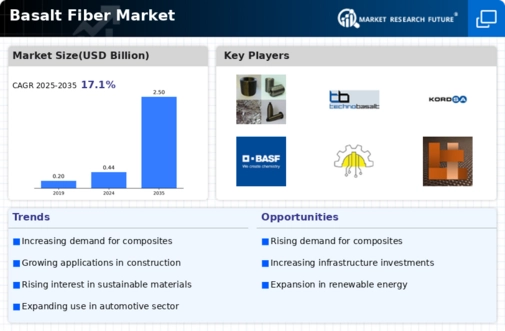Top Industry Leaders in the Basalt Fiber Market

Basalt Fiber Market
The basalt fiber market, though nascent, is surging with promise. Touted as a sustainable and high-performance alternative to traditional fibers like glass and carbon, basalt is finding its way into an increasingly diverse range of applications. This dynamic landscape, however, is teeming with competition, with established players jostling for position alongside a wave of innovative startups. Examining the strategies, market share drivers, and recent developments is crucial to understanding the basalt fiber market's trajectory.
Market Share Drivers: A Complex Game of Factors
Dominating the market share battle are several key factors:
-
Cost and Availability: Raw basalt is readily available and significantly cheaper than carbon fiber, making it an attractive option for cost-conscious applications. Advancements in production technologies are further driving down costs and boosting supply. -
Regional Demand: Asia Pacific, particularly China, Japan, and India, accounts for the lion's share of the market due to robust infrastructure development and increasing awareness of basalt's benefits. Europe and North America are also witnessing notable growth. -
Application Diversity: Basalt's versatility is a major draw. From construction and infrastructure reinforcements to automotive and marine components, wind energy blades, and electrical insulation, the applications seem endless. This diversification mitigates risk and opens new growth avenues. -
Sustainability Appeal: Environmental consciousness is fueling the demand for sustainable materials. Basalt's volcanic origin and recyclability resonate with eco-conscious consumers and brands, giving it an edge over traditional fibers.
Strategies for Success: A Blend of Innovation and Collaboration
Market leaders are adopting a mix of strategies to navigate this competitive terrain:
-
Vertical Integration: Companies like TBM Holding and Basaltex are securing their supply chains by acquiring basalt quarries and production facilities. This ensures consistent quality and cost control. -
Product Development: Continuous research and development are leading to improved basalt fiber properties, like enhanced tensile strength and fire resistance. This opens doors to new applications and market segments. -
Strategic Partnerships: Collaborations with research institutions, universities, and end-user industries are accelerating innovation and application development. -
Market Awareness: Educational campaigns and industry events are crucial in raising awareness about basalt's properties and potential. Building a strong brand identity is also key.
Key Companies in the Basalt Fiber market include
- Kamenny Vek (Russia)
- Galen Ltd (Russia)
- Technobasalt Invest LLC (Ukraine)
- Albarrie Canada Limited (Canada)
- Zhejiang GBF Basalt Fiber Co. Ltd (China)
- Sudaglass Fiber Technology (China)
- Mafic SA (Ireland)
- Shanxi Basalt Fiber Technology Co. Ltd (China)
- Basaltex (Belgium)
- Jiangsu Tianlong Continuous Basalt Fiber Co. Ltd (China)
- INCOTELOGY GmbH (Germany)
- Mudanjiang Basalt Fiber Co. Ltd (China)
- Basalt Fiber Tech
- Deutsche Basalt Faser GmbH
- Jumeisheng
- Basalt Fibers
- China Beihai Fiberglass Co., Ltd.
- LAVAintel
Recent Developments:
-
September 2023: Swiss startup, Arges, secures $12 million in funding to expand its production of basalt fiber-based composite rebars for the construction sector. -
October 2023: The International Basalt Fiber Association (IBFA) hosts its inaugural conference in Frankfurt, Germany, bringing together industry stakeholders to discuss market trends and collaboration opportunities. -
November 2023: Chinese basalt fiber producer, Zhejiang Hengshengda Basalt Fiber Technology Co., Ltd., announces plans to build a new production facility in North America, targeting the growing demand in the region. -
December 2023: A research study by MIT highlights the potential of basalt fiber composites for lightweighting aircraft structures, paving the way for more fuel-efficient airplanes.
